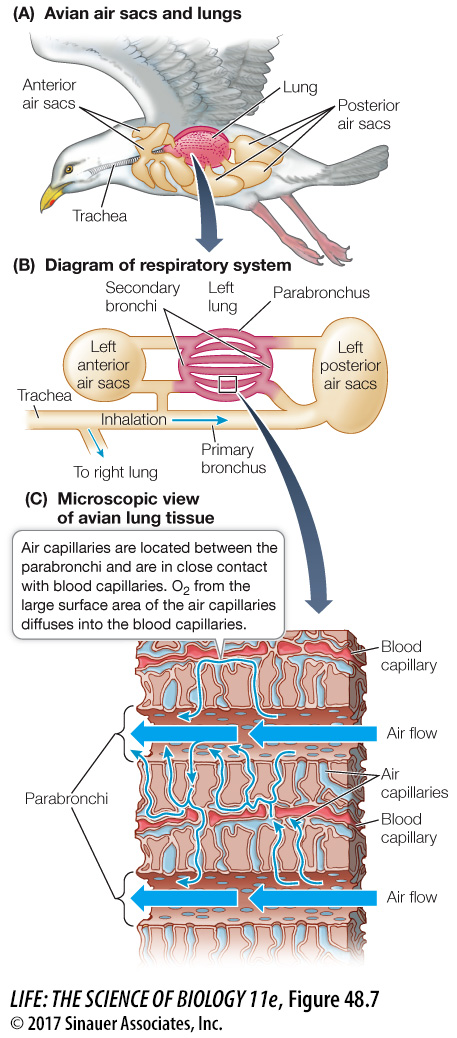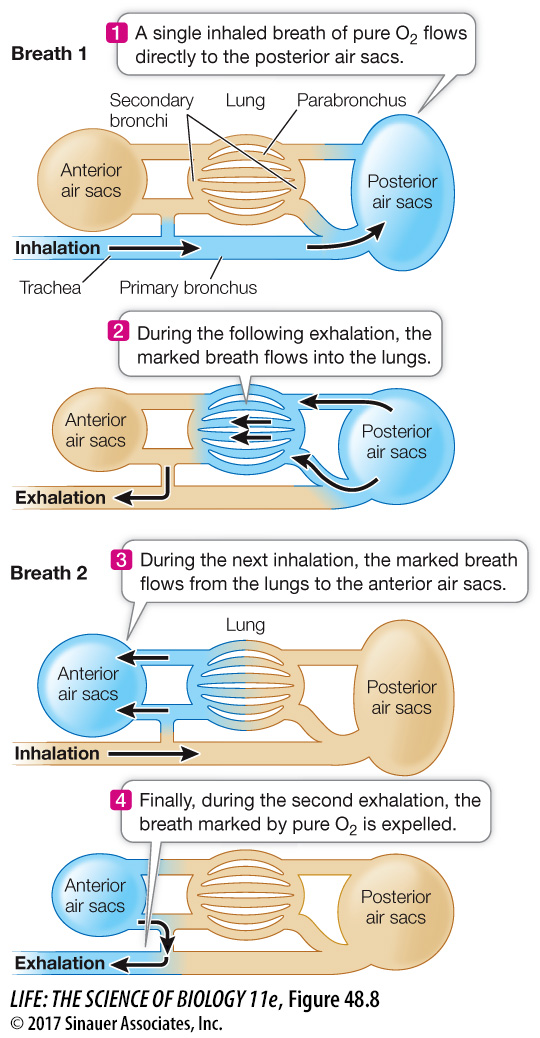Birds use unidirectional ventilation to maximize gas exchange
Birds are remarkable for their ability to sustain high levels of activity for a long time—
The structure of bird lungs allows air to flow unidirectionally through the lungs, rather than bidirectionally through all the same airways, as it does in tidally ventilating mammals (discussed below). Because mammalian lungs are never completely emptied of air during exhalation, there is always some lung volume that is not ventilated with fresh air. The air remaining in lungs and airways after exhalation is called dead space. Bird lungs, by contrast, have very little dead space, and the fresh incoming air is not mixed with stale air. In this way, a high PO2 gradient is maintained.
Air sacs are an important and unique feature of the avian respiratory system, and they occupy much of the body cavity of the bird (Figure 48.7A). They can be divided into a group of anterior air sacs and a group of posterior air sacs. The air sacs are interconnected with each other, with the lungs, and with air spaces in some of the bones. The air sacs are not gas exchange surfaces; rather, they act as bellows to maintain a unidirectional flow of air through the lungs.

As in other air-
Branching off the parabronchi are numerous tiny air capillaries (Figure 48.7C). Air flows through the parabronchi and diffuses into the air capillaries, which are the gas exchange surfaces. The air capillaries are so numerous that they provide an enormous surface area for gas exchange. The blood capillaries are in close contact with the air capillaries, and oxygen from the air diffuses into the blood. The parabronchi coalesce into larger bronchi that take the air out of the lungs and into anterior air sacs and then back to the trachea. Thus the anatomy of a bird’s airways allows air to flow unidirectionally through the lungs: trachea, bronchi, posterior air sacs, parabronchi, bronchi, anterior air sacs, trachea.
The puzzle of how birds breathe was solved by placing small O2 sensors at different locations in birds’ air sacs and airways. The birds were then allowed to inhale pure O2 for just a single breath, which made it possible to track that particular breath by recording when each of the O2 sensors registered a peak value. The experiment showed that a single breath remains in a bird’s respiratory system for two cycles of inhalation and exhalation. During inhalation, the air sacs expand and air flows through the trachea into the posterior air sacs. At the same time, the lungs are contracting as air moves from the lungs into the anterior air sacs. During exhalation, the air sacs contract. The posterior air sacs push air into the lungs, which are expanding, and the anterior air sacs push air into the trachea and out of the respiratory system. This bellowslike action of the air sacs maintains a continuous, unidirectional flow of fresh air through the lungs (Figure 48.8).

Animation 48.1 Airflow in Birds
The advantages of the bird respiratory system are similar to those of fish gills. The air sacs keep fresh air flowing unidirectionally over the gas exchange surfaces without interruption. Thus those gas exchange surfaces are constantly exposed to a PO2 that is very close to that of the ambient air. Even at high altitude where the PO2 of the ambient air may be only slightly above that of the blood, O2 can still diffuse from air to blood.